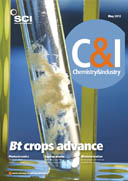Nuggets of wisdom
Reviewer
John Emsley
Every Molecule Tells a Story, Editor: Simon Cotton, Publisher: CRC, Pages: 266, Price: £38.99, ISBN: 978-1-4398-0773-6
This book does exactly what its title says. It combines information about 200 or so chemicals with nuggets of human interest, covering such diverse topics as pop groups and battles of empire. Thus we learn that the sixties pop group Small Faces celebrated the methyl derivative of amphetamine (aka speed or nice) with their hit Here Comes the Nice. And the 1980s pop group Dexys Midnight Runners based its name on dexedrine, the dextro-isomer of amphetamine, another popular recreational drug. In the same chapter we also learn that the Antarctic explorer Sir Ernest Shackleton relied on cocaine to maintain his stamina on long expeditions.
More seriously, another chapter on explosives, tells how the lack of research in this area left the Royal Navy at a disadvantage in World War I. The navy relied on 2,4,6-trinitrophenol (lyddite) as the explosive for its shells but these could not deliver blows powerful enough to penetrate strong armour. The German navy used the more powerful trinitrotoluene (TNT). The result was that at the Battle of Jutland in 1916 the British lost three battleships, three cruisers, eight destroyers, and 6000 seamen. German losses were much less.
Simon Cotton has been writing science for a wide audience for many years; witness his many contributions to Bristol University’s Molecule of the Month website and his column, Soundbite molecules, in Education in Chemistry. Whenever I read his contributions it is rare for me not to say to myself, ‘I didn’t know that’ which I am sure readers of this book will find themselves saying.
Every Molecule Tells a Story consists of 14 chapters, beginning with the atmosphere and its gases, and ending with synthetic polymers, where you learn of the nylon riots when women fought to obtain stockings made from the new fibre.
There are chapters devoted to steroids and sex, the human senses, cosmetics and perfumes, poisons both natural and man-made, pleasure molecules, and healing drugs both natural and man-made.
In one chapter, we learn about the highly dangerous toxins that nature produces, of which the tetrodoxin of the puffer fish is particularly deadly. This poison blocks the Na+ channels in the body, causing paralysis, and there is no known antidote. Despite this, the fish is eaten – the Japanese delicacy fugu – though it must be prepared by specially trained chefs to ensure the parts of the fish which contain the toxin have been removed. Cotton reveals that the great explorer Captain James Cook ate puffer fish when he first visited Polynesia in 1774, apparently without ill effects.
There is a chapter devoted to the drugs which chemists have produced down the years and which have relieved a great deal of human suffering. Here you discover how the β-blocker propanolol was made using α-naphthol because there was no β-naphthol in the laboratory that day. This led to a major drug breakthrough, which for more than 50 years has given those suffering heart disease a longer life.
In some areas, the content interacts with us at the molecular level. ‘Smell is the most chemical of the senses’ is how Cotton introduces perfumes and explains that the human nose has the remarkable ability to analyse and differentiate molecules with remarkable accuracy. Today we even know why Chinese roses smell like tea leaves, while European ones have a floral scent. The reason is linked to a difference of one amino acid in the enzymes which produce the scent molecules.
One of the most interesting stories is that of Lance Armstrong. In 1996, he was ignoring a swollen testicle and intense headaches until he was coughing up blood, when he finally sought medical help. Armstrong was diagnosed with testicular cancer with cancerous spots in his brain and lungs. After operations to remove the tumours in his brain, he was put on a course of chemotherapy, which included the platinum complex Cisplatin, PtCl2(NH3)2, first made in 1845. This worked perfectly and cured his cancer. Armstrong then went on to win the Tour de France every year from 1999 to 2005.
The book is targeted at students of chemistry, who are already familiar with the language of our science, and for this reason it includes a lot of chemistry and molecular detail. Sadly, this will deter readers who are non-chemists but might well enjoy the tales Cotton has to tell. Were they to read his book, they would appreciate how all-pervading our science is, and understand better its role in the modern world.
John Emsley is a freelance writer based in Cambridge, UK.
The best way to keep up to date with all of the latest, cutting edge technologies from the lab to the market!
Author
Publisher
Pages
Price
ISBN





